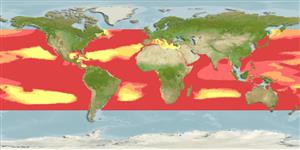>
Anguilliformes (Eels and morays) >
Nemichthyidae (Snipe eels)
Etymology: Nemichthys: Greek, nema, -atos = filament + Greek, ichthys = fish (Ref. 45335); scolopaceus: From the Latin 'scolopax' referring to the long bill-like jaws (Ref. 6885).
More on author: Richardson.
Environment: milieu / climate zone / depth range / distribution range
पारिस्थितिकी
समुद्री बैथीपिलाजिक; गहराई सीमा 0 - 4337 m (Ref. 96339), usually 100 - 1000 m (Ref. 58302). Deep-water; 55°N - 42°S, 180°W - 180°E
Worldwide in tropical and temperate seas. Western Atlantic: Nova Scotia, Canada and northern Gulf of Mexico to Brazil. Eastern Atlantic: Spain to South Africa, including western Mediterranean (Ref. 3247); reported from Iceland (Ref. 12462). Regularly found in the Skagerrak (Ref. 35387). Northwest Pacific: Japan (Ref. 6885) and Arafura Sea (Ref. 9819). Eastern Pacific: Alaska (Ref. 6885) to Chile (Ref. 9068), including the Gulf of California (Ref. 32364).
आकार / वज़न / Age
Maturity: Lm ? range ? - ? cm
Max length : 130 cm TL पुल्लिंग / अलिंग; (Ref. 35388)
पृष्ठीय रीढ़ (सम्पूर्ण) : 0; गुदा कांटा: 0. Jaws long (Ref. 13608). Posterior end of body narrow, ending as a long filament (Ref. 13608). Dorsal fin with about 350 rays; caudal fin not recognizable; anal fin with about 320 (Ref. 6885). Dark brown or grey in color, often darker below (Ref. 3248); anal fin and tips of pectoral fins almost black (Ref. 6885).
Occur in midwater, usually below 400 m and occasionally in shallow water in the northern part of its range. Feed on crustaceans while swimming with its mouth open (Ref. 5377). Mesopelagic (Ref. 58302) and bathypelagic (Ref. 58426). Oviparous, with planktonic leptocephali (Ref. 32364). Degenerative changes in males and females suggest semelparity (Ref. 32364). Minimum depth reported taken from Ref. 86942.
Life cycle and mating behavior
Maturities | पुनरुत्पत्ति | Spawnings | Egg(s) | Fecundities | लार्वा
Nielsen, J.G. and D.G. Smith, 1978. The eel family Nemichthyidae (Pisces, Anguilliformes). Carlsberg Found., Dana-Rept. No. 88:71 p. (Ref. 7450)
IUCN Red List Status (Ref. 130435)
Threat to humans
Harmless
Human uses
मात्स्यिकी: कोई रुचि बग़ैर
साधन
Special reports
Download XML
इंटरनेट स्रोत
Estimates based on models
Preferred temperature (Ref.
123201): 4.3 - 21.1, mean 10.2 °C (based on 3474 cells).
Phylogenetic diversity index (Ref.
82804): PD
50 = 0.6270 [Uniqueness, from 0.5 = low to 2.0 = high].
Bayesian length-weight: a=0.00102 (0.00046 - 0.00225), b=3.06 (2.88 - 3.24), in cm total length, based on all LWR estimates for this body shape (Ref.
93245).
Trophic level (Ref.
69278): 3.5 ±0.0 se; based on diet studies.
Generation time: 3.7 ( na - na) years. Estimated as median ln(3)/K based on 1
growth studies.
लौटाव (Ref.
120179): निम्न, न्यूनतम जनसंख्या दुगनी होने का समय 4.5 - 14 वर्ष। (K=0.30; assuming semelparity with tm>5).
Fishing Vulnerability (Ref.
59153): Moderate to high vulnerability (51 of 100).
Nutrients (Ref.
124155): Calcium = 19 [6, 42] mg/100g; Iron = 0.295 [0.130, 0.805] mg/100g; Protein = 18.3 [15.8, 21.0] %; Omega3 = 0.177 [0.057, 0.572] g/100g; Selenium = 34.9 [11.9, 103.1] μg/100g; VitaminA = 9.08 [1.04, 75.23] μg/100g; Zinc = 0.379 [0.201, 0.745] mg/100g (wet weight);
